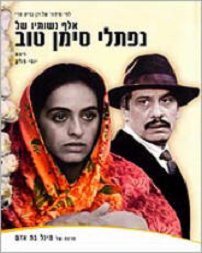| A Thousand and One Wives | |
|---|---|
 DVD cover | |
| אלף נשותיו של נפתלי סימן טוב | |
| Directed by | Michal Bat-Adam |
| Written by | Michal Bat-Adam |
| Based on | ״אלף נשותיו של נפתלי סימן טוב״ by Dan Benaya-Serri |
| Produced by | Effi Atad |
| Starring |
|
| Cinematography | Yoav Kosh |
| Edited by | Yosef Grunfeld |
| Music by | Alon Oleartchik |
Production companies |
|
Release date |
|
Running time | 90 Minutes |
| Country | Israel |
| Language | Hebrew |
A Thousand and One Wives ( Hebrew: אלף נשותיו של נפתלי סימן טוב, tr. Elef Neshotav Shel Naftali Siman-Tov, literally "Naftali Siman-Tov's Thousand Wives") is a 1989 Israeli independent underground dramatic-historical art film directed by Michal Bat-Adam. [1]
Synopsis
In the Bukharim quarter, Jerusalem, during the 1920s, merchant Naftali Siman-Tov ( Yossi Pollak) is a wealthy middle-aged widower, all of whose previous wives have died under mysterious circumstances. He fears getting married again due to believing that he is cursed. A local matchmaker, Arotchas ( Salim Daw), with the help of some old ladies, pressures him to get married again nonetheless, and, eventually, he marries Flora ( Rita Jahanforuz), a naïve 24-year-old virgin. However, in order not to bestow his alleged curse upon her, he avoids all physical touch. Flora gets pregnant as a result of sleeping with a local textile salesman, Hamedian ( Jonathan Cherchi), and, Naftali, unable to bear the shame, becomes violent toward his young wife. [2] [3]
Reception
Writing in Haaretz, critic Uri Klein opined that Rita Jahanforuz "adds to this film a significant amount of humanity and humor, and, she has a natural filmic presence," [4] while Yedioth Ahronoth critic Nachman Ingber wrote that the film presents "a cornucopia of beautiful colors, [showing] a Jerusalem of towels, handsome tools, and, scarfs, really a wonderful parade of lots of tradition, customs, and, folklore, representing all Twelve Tribes of Israel, as if it were a beautiful exhibition by Maskit, with a well-spoken text," [5] Davar critic Oshra Schwartz noted that the film's main achievement is its treatment of color and light, namely, that the cinematography "creates an almost perfect match between the view that can be seen through the vast Jerusalemite windows (in which the characters walk) and the large rooms within the old tastefully and colorfully decorated stone-made houses," [6] and Al HaMishmar critic Yael Israel underscored that the film is Michal Bat-Adam's "best and most wholesome film" to date, due to its "reliable and reserved cinematic language creating a correct historical environment and utilizing glowing and careful acting." [7]
References
- ^ Sason, Yasmin; Parkhomovsky, Marat (20 December 2010). מיכל בת־אדם. Israeli Cinema Testimonial Database (in Hebrew). Retrieved 31 March 2017.
- ^ Israel, Yael (5 May 1989). הולכת אחרי חושיה [Going After Her Senses] (PDF). Al HaMishmar (in Hebrew). Tel Aviv. Retrieved 22 March 2017.
- ^ Shuv, Yael (5 May 1989). אומרים לי לשחק קטן [I Was Told to Play Small Roles] (PDF). Davar (in Hebrew). Tel Aviv. Retrieved 22 March 2017.
- ^ Klein, Uri (11 May 1989). הפוטנציאל של ריטה [Rita's Potential] (PDF). Haaretz (in Hebrew). Tel Aviv. Retrieved 22 March 2017.
- ^ Ingber, Nachman (12 May 1989). אלף בעיותיה של בת־אדם [Bat-Adam's Thousand Problems] (PDF). Yedioth Ahronoth (in Hebrew). Tel Aviv. Retrieved 22 March 2017.
- ^ Schwartz, Oshra (14 May 1989). על החלטות נכונות ושגויות [On Correct and Incorrect Decisions] (PDF). Davar (in Hebrew). Tel Aviv. Retrieved 22 March 2017.
- ^ Israel, Yael (19 June 1989). סיפור פשוט [A Simple Story] (PDF). Al HaMishmar (in Hebrew). Tel Aviv. Retrieved 22 March 2017.
External links
- 1989 films
- 1980s Hebrew-language films
- 1980s historical drama films
- 1980s pregnancy films
- 1989 drama films
- 1989 independent films
- Israeli historical drama films
- Israeli independent films
- Israeli pregnancy films
- Films based on short fiction
- Films directed by Michal Bat-Adam
- Films about businesspeople
- Films about old age
- Films about widowhood
- Films about adultery
- Films set in the 1920s
- Films set in Jerusalem
- Films shot in Israel